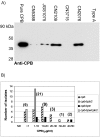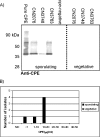Dissecting the contributions of Clostridium perfringens type C toxins to lethality in the mouse intravenous injection model
- PMID: 16926413
- PMCID: PMC1594841
- DOI: 10.1128/IAI.00534-06
Dissecting the contributions of Clostridium perfringens type C toxins to lethality in the mouse intravenous injection model
Abstract
The gram-positive anaerobe Clostridium perfringens produces a large arsenal of toxins that are responsible for histotoxic and enteric infections, including enterotoxemias, in humans and domestic animals. C. perfringens type C isolates, which cause rapidly fatal diseases in domestic animals and enteritis necroticans in humans, contain the genes for alpha toxin (plc), perfringolysin O (pfoA), beta toxin (cpb), and sometimes beta2 toxin (cpb2) and/or enterotoxin (cpe). Due to the economic impact of type C-induced diseases, domestic animals are commonly vaccinated with crude type C toxoid (prepared from inactivated culture supernatants) or bacterin/toxoid vaccines, and it is not clear which toxin(s) present in these vaccines actually elicits the protective immune response. To improve type C vaccines, it would be helpful to assess the contribution of each toxin present in type C supernatants to lethality. To address this issue, we surveyed a large collection of type C isolates to determine their toxin-producing abilities. When late-log-phase vegetative culture supernatants were analyzed by quantitative Western blotting or activity assays, most type C isolates produced at least three lethal toxins, alpha toxin, beta toxin, and perfringolysin O, and several isolates also produced beta2 toxin. In the mouse intravenous injection model, beta toxin was identified as the main lethal factor present in type C late-log-phase culture supernatants. This conclusion was based on monoclonal antibody neutralization studies and regression analyses in which the levels of alpha toxin, beta toxin, perfringolysin O, and beta2 toxin production were compared with lethality. Collectively, our results highlight the importance of beta toxin for type C-induced toxemia.
Figures







References
-
- Bruce, R. D. 1985. An up-and-down procedure for acute toxicity testing. Fundam. Appl. Toxicol. 5:151-157. - PubMed
-
- Bueschel, D. M., B. H. Jost, S. J. Billington, H. T. Trinh, and J. G. Songer. 2003. Prevalence of cpb2, encoding beta2 toxin, in Clostridium perfringens field isolates: correlation of genotype with phenotype. Vet. Microbiol. 94:121-129. - PubMed
Publication types
MeSH terms
Substances
Associated data
- Actions
- Actions
- Actions
- Actions
Grants and funding
LinkOut - more resources
Full Text Sources
Molecular Biology Databases
Research Materials
Miscellaneous

